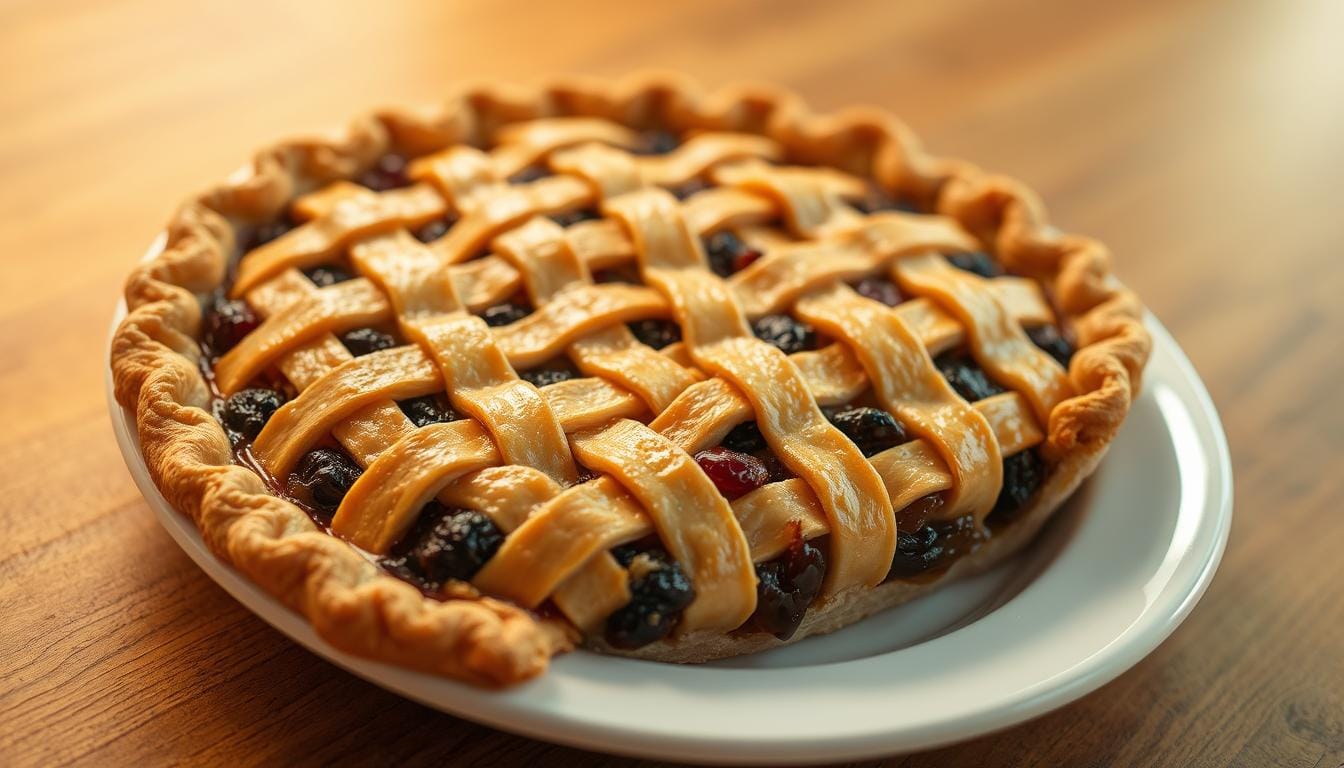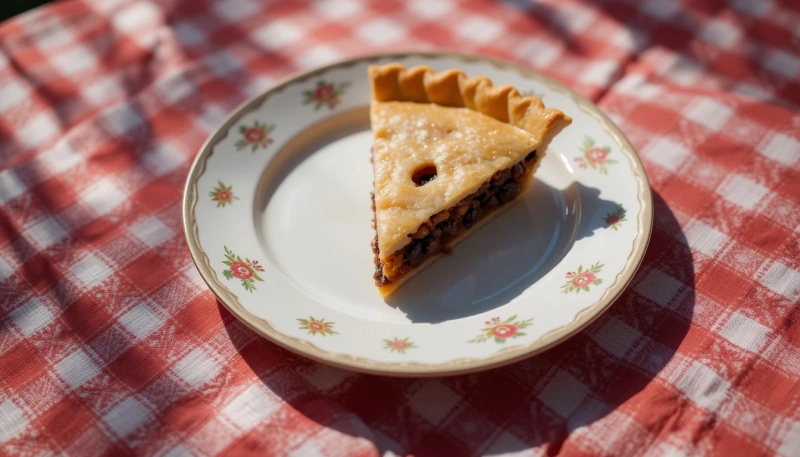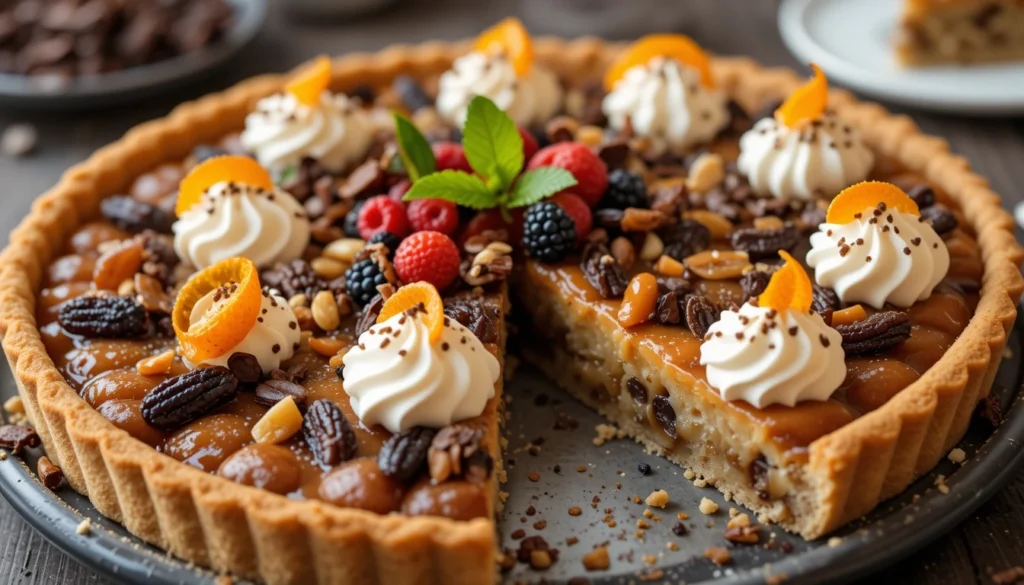Raisin Pie: How to Make a Classic Pie from Scratch

Raisin pie is a timeless treat that combines rich raisins with a flaky crust. It’s a dessert that’s both nostalgic and delicious. This vintage recipe focuses on simplicity, using raisins as the star ingredient.
Every bite highlights the natural sweetness of the dried fruit. It’s balanced by warm spices like cinnamon and a touch of buttery richness.
Mastering this raisin pie involves precise steps. From pre-cooking the filling to ensuring the perfect golden crust. Whether you’re using store-bought dough or making it from scratch, this guide ensures your homemade version rivals bakery-quality pies.
Follow these tips for a dessert that’s both comforting and crowd-pleasing.
Table of Contents
The Rich History of Traditional Raisin Pie
Traditional raisin pie is a special part of American cooking history. It dates back to when kitchens used simple ingredients like raisins, flour, and spices. This pie was more than just a sweet treat; it showed how people worked together and were resourceful.
“Raisin pie is part of a larger tradition of pies that can be whipped up on short notice from pantry ingredients.”
Picture baking in the 19th century. Raisins, brought from California or Europe, were a rare but useful item. For the Amish, these pies were known as “funeral pies,” given to comfort those who mourned. They were perfect for big gatherings because they lasted long and were easy to make.
Today, some bakers in the Ozarks make pies from old recipes. They use recipes from the 1897 White House cookbook and Fannie Farmer’s 1895 book. This effort, called the Ozarks Pie Project, has brought back over 65 classic recipes.
- Midwestern spiced versions with cinnamon and cloves
- Southern nutty fillings blending walnuts
- California citrus-infused pies
The Great Depression made old-fashioned raisin pie even more important. Grandma Phoebe’s simple recipe shows how families made do with little. Recipes like Melanie Nichols’ Three-Layer Raisin Pie from Missouri’s Community Days Cookbook add to the pie’s rich history.
Now, this pie stands for strength. Its journey from a necessary food to a beloved treat shows us the power of history. Bakers today still look for old cookbooks to make this pie. They want to taste the past, but with a modern twist.
Essential Ingredients for the Perfect Raisin Pie
Creating the best raisin pie recipe begins with knowing each ingredient’s role. Let’s explore the key components that make a classic raisin pie a true masterpiece.
| Raisin Type | Taste | Texture |
|---|---|---|
| Golden Raisins | Mild, honey-like sweetness | Plump and tender when baked |
| Regular Raisins | Deep, dried fruit flavor | Soft and chewy |
| Jumbo Raisins | Intense, concentrated sweetness | Large, juicy bursts of flavor |
Choosing quality raisins is crucial. Look for plump, moist raisins without shriveled pieces. Cinnamon balances their sweetness, and cornstarch makes the filling silky. Butter adds richness, and a double crust—whether all-butter or shortening-based—gives that flaky texture.
- Sugar: Enhances raisin flavor and caramelizes during baking.
- Flour: Stabilizes the filling to prevent sogginess.
- Salt: Brings out natural sweetness and deepens complexity.
For substitutions, try dark brown sugar for a deeper flavor. Always fluff flour before measuring to avoid a dense crust. These tips transform simple ingredients into a timeless treat.
Preparing Your Raisin Pie Filling
Getting the filling right is crucial for a tasty raisin pie. While raisin pie filling canned is available, making it from scratch brings out the best flavors. Here’s how to do it perfectly.
Selecting and Preparing the Raisins
Pick plump raisins, mixing golden and dark for a richer taste. Rinse them in cold water to get rid of any dirt. If your raisins are dry, soak them in warm water for 10 minutes. Then, drain them well before cooking.
Creating the Perfect Sweet Filling Consistency
In a saucepan, mix raisins with water. Boil, then lower the heat. Add brown sugar, cornstarch, cinnamon, and salt, stirring until smooth. Cook for 3 minutes until it thickens.
Stir in butter and vinegar to balance the sweetness. The filling should coat a spoon without being too sticky.
Flavor Enhancers That Complement Raisins
- Add citrus zest or extract for brightness
- Try spices like nutmeg or mace for warmth
- Use a splash of rum or brandy for complexity
Common Mistakes to Avoid
Don’t rely too much on raisin pie filling canned without checking its texture. Cooking raisins for too long can make them mushy. Stop boiling after 5 minutes.
Always cool the filling before putting it in the crust. Hot filling can melt the crust’s butter. Test the thickening by drizzling the mixture on a chilled plate. It should hold its shape briefly.
Mastering the Old-Fashioned Raisin Pie Crust
Creating a flaky crust is crucial for a traditional raisin pie. It must balance sweet filling with a crisp texture. Begin by mixing 2½ cups of all-purpose flour, ½ tsp of salt, and 1 cup of cold butter (cut into pieces) until it resembles coarse crumbs.
Slowly add ice water, 1 tbsp at a time, until the dough comes together. Split it into two disks and chill for 1 hour. This step relaxes the gluten, preventing the crust from shrinking.

| Fat Type | Flavor | Flakiness |
|---|---|---|
| Butter | Rich, aromatic | Moderate layers |
| Shortening | Neutral | Superb flaky layers |
| Lard | Buttery, subtle | Extremely flaky |
For the best crust, mix butter and shortening as suggested in Baking and Pastry: Mastering the Art and Craft. Don’t overwork the dough to avoid toughness. Roll it out between parchment to keep it cold.
To make the crust even more tender, replace 1 cup of all-purpose flour with pastry flour. This reduces gluten development. Blind bake the bottom crust at 375°F for 15 minutes before adding the filling. This step prevents sogginess.
- Too tough? Dough was overmixed or too warm
- Edges shrinking? Stretch dough gently while rolling
- Greasy patches? Use a bench scraper to fold dough without stretching
Step-by-Step Raisin Pie Assembly Guide
To make your simple raisin pie recipe, layer carefully to avoid cracks or leaks. Start by dusting your surface with flour to prevent sticking. Roll the bottom crust to 1/8-inch thickness. Here’s how to proceed:
Correctly Filling Your Pie Shell
Place the rolled dough in a 9-inch pie plate using the fold-and-roll method. Fill the shell evenly with the filling, leaving ½ inch at the top. Avoid overfilling to prevent overflow during baking.
Creating Decorative Top Crusts
- Roll the second dough round to 1/8-inch thickness.
- Cut into ½-inch-wide strips for lattice work, arranging them diagonally over the filling.
- Pinch the top and bottom crusts together at the edges, then crimp with fingers or a fork for a tight seal.
Ensuring Proper Ventilation for Baking
Make 4-6 slits in the top crust or use a lattice design to vent steam. Brush the crust with an egg wash for a golden color. Sprinkle with sugar for texture. Bake as instructed in the recipe.
Proper sealing and ventilation are key to avoid soggy layers. Adjust the lattice spacing for airflow and check dough thickness before baking. These steps will make your simple raisin pie recipe a standout dessert.
Baking Your Raisin Pie to Golden Perfection
To make your raisin pie the best, mastering the baking process is key. Follow these steps for a crust that’s crisp and a filling that’s fully set.
Temperature Recommendations
For the best results, use this two-stage method:
| Stage | Temperature | Time |
|---|---|---|
| Initial Bake | 425°F | First 15 minutes |
| Final Bake | 375°F | Remaining 25–30 minutes |
Place your pie on the lower rack to keep the bottom crust from getting soggy.
Visual Cues for Doneness
- Crust: Golden-brown hue with no pale spots
- Filling: Bubbles visible through vents or lattice gaps
- Edges: Slightly darker than the center, but not charred
Check the bottom crust by gently tapping it. If it’s firm, it’s done.
Troubleshooting Common Issues
Fix these problems before serving:
- Soggy crust: Make sure the filling thickens well before baking. Cool it down before putting it in the pie crust.
- Overly dark edges: Use foil strips to cover the edges halfway through baking.
- Undercooked filling: Bake for longer, in 5-minute increments, and check often.
Always use an oven thermometer—displayed temperatures can vary by up to 50°F.
Let the pie cool on a wire rack for 3+ hours. This ensures the filling sets completely. Rushing this step can make the slices runny.
Simple Raisin Pie Recipe Variations
“Spice it up: This raisin pie is a simple, classic version of the traditional favorite. Many other recipes are ‘blinged out’ with additional flavorings, so feel free to add in anything you’ve enjoyed with raisins in other recipes.”
Make your raisin pie stand out with these simple changes. For a creamy raisin cream pie recipe, mix eggs, sugar, and sour cream. Add soaked raisins and top with meringue for a smooth contrast. This makes the pie a real showstopper without adding complexity.
- Add raisin pie depth with spices like nutmeg, mace, or a dash of almond extract.
- Swap half the raisins with cranberries and a splash of rum extract for a mock cherry twist.
- Stir in lemon zest or orange peel for citrus brightness, or sprinkle chopped pecans for crunch.
- Replace sour cream with Greek yogurt for a lighter texture, or use gluten-free crust for dietary needs.
Try adding vanilla bean seeds to the filling or a cinnamon-sugar topping. For a boozy touch, add a teaspoon of brandy extract. Double the recipe for a crowd in a deep-dish crust. Always seal meringue edges to the crust to prevent weeping. These tweaks keep your raisin pie delicious for any occasion.
Serving Suggestions for Your Homemade Raisin Dessert
Make your raisin dessert recipes shine with these easy tips. Whether it’s for family or guests, these ideas will make your pie unforgettable.
Complementary Toppings and Accompaniments
Take your raisin pie to the next level with these extras:
- Top with vanilla ice cream or whipped cream with cinnamon or vanilla.
- Add crunch with chopped walnuts, pecans, or a sprinkle of granola.
- Pair with sharp cheddar cheese for a sweet and savory mix, a New England favorite.
- Drizzle with caramel sauce or crème anglaise for extra flavor.
Temperature Considerations for Serving
The serving temperature can change the whole experience. Here’s what to consider:
| Temperature | Best For |
|---|---|
| Cold | Refreshing texture; great with warm drinks like coffee or spiced tea. |
| Room Temperature | Best for tasting the dessert’s natural sweetness. |
| Warmed | Brings out the aroma and softens the filling—perfect for winter. |
Presentation Ideas for Special Occasions

- Mini pies for parties or dessert bars.
- Garnish with candied orange peel or mint sprigs for color.
- Create a “dessert bar” with toppings like caramel, nuts, and cream for customization.
- Layer slices on a platter with seasonal berries or chocolate shavings.
Pair with port wine, brandy, or ice wine for a fruitier taste. For brunch, serve with morning coffee or tea.
Storing and Preserving Your Raisin Pie
Keeping your raisin pie fresh is key. Let it cool completely on a wire rack before covering. For short-term, store it at room temperature (covered) for up to 2 days or refrigerate for 5-7 days. Always use aluminum foil in the fridge to avoid moisture buildup.
| Storage Method | Duration | Notes |
|---|---|---|
| Room Temperature | 2-3 days | Cover tightly; best for warm climates |
| Refrigerator | 5-7 days | Wrap securely; reheat before serving |
| Freezer | 3 months | Wrap twice in foil; mark the date |
Freezing is great for long-term storage. Here’s how:
- Wrap baked or unbaked raisin pie tightly in plastic wrap and aluminum foil
- Unbaked pies can go straight into the oven from frozen—add 20-45 minutes to baking time
- Separate slices on a baking sheet before freezing for easy portion use later
Reheat baked pies at 375°F for 10-15 minutes to restore crispness. Check for mold or off smells before serving—discard if spoilage signs appear. To revive a soggy crust, warm the pie in a 350°F oven for 5-7 minutes.
By following these steps, you can enjoy your raisin pie for weeks or months. Proper storage keeps the filling moist and the crust intact. This way, every slice will taste like it just came out of the oven.
Conclusion: Enjoying the Fruits of Your Raisin Pie Labor
Baking old-fashioned raisin pie connects you to a tradition of comfort food. It’s simple yet meaningful. From mixing cinnamon and nutmeg to brushing the crust, it’s a tribute to home cooks.
This recipe has stood the test of time. It’s loved for its balanced flavors and flexibility. Bakers enjoy tweaking it to make it their own.
Many praise the recipe for being easy to follow and not too sweet. Adding spices or walnuts makes it special. Some age the filling for a deeper flavor, showing small changes can make a big difference.
The pie is a family favorite, enjoyed at holidays and casual dinners. It’s often paired with coconut whipped cream or date syrup for a modern twist. Leftovers can be stored in the fridge for four days or frozen for later.
Sharing the recipe online or at gatherings connects you to a community of bakers. It’s a way to preserve culinary heritage.
Old-fashioned raisin pie is more than a dessert; it’s a story. It shows how patience and creativity can turn simple ingredients into cherished memories. Every bite is a testament to the effort put into making it.
Whether you add rum-soaked raisins or a sprinkle of powdered sugar, this pie is a tradition worth savoring. Its timeless appeal comes from its ability to evolve while staying true to its roots. It’s a dessert that will be cherished for generations to come.
FAQ
What is the best raisin pie recipe?
The top raisin pie recipe combines a flaky crust with a sweet filling. It uses plump raisins, brown sugar, cinnamon, and a bit of vinegar or lemon. This mix creates a comforting dessert that sticks to traditional methods.
What is traditional raisin pie often called?
Traditional raisin pie is also known as “funeral pie,” especially in Amish communities. It’s called this because it was often served at mourning gatherings. Its ingredients lasted long and it was quick to make, perfect for hard times.
Can I use canned raisin pie filling instead of making my own?
Yes, canned raisin pie filling is an easy option. But, homemade filling usually tastes better and has a nicer texture. If you choose canned, check the ingredients for quality and sweetness.
What are some common mistakes to avoid when making raisin pie?
Avoid undercooking the filling to prevent a runny pie. Also, don’t over-thicken the mixture or rush the cooling. Make sure to soak the raisins well and cool the filling before adding it to the crust.
What variations can I try for my raisin pie recipe?
Try raisin cream pie for a richer flavor or add spices, citrus zest, or nuts for texture. You can also make a mock cherry version by mixing raisins with cranberries for a unique taste.
How should I store my leftover raisin pie?
Cool your pie completely and store it covered at room temperature for 2-3 days. For longer storage, refrigerate it for 5-7 days or freeze it for even longer. Always reheat it in the oven for the best taste.
What toppings pair well with raisin pie?
Top raisin pie with whipped cream or vanilla ice cream for a classic choice. For something different, try caramel sauce, crème anglaise, or sharp cheddar cheese. These toppings add a unique twist.
Can I personalize my raisin pie recipe?
Absolutely! You can change the spices, use different raisins, or add bourbon or nuts. This lets you tailor the pie to your liking, making it uniquely yours.
How did you like the recipe?
There are no reviews yet. Be the first one to write one.
